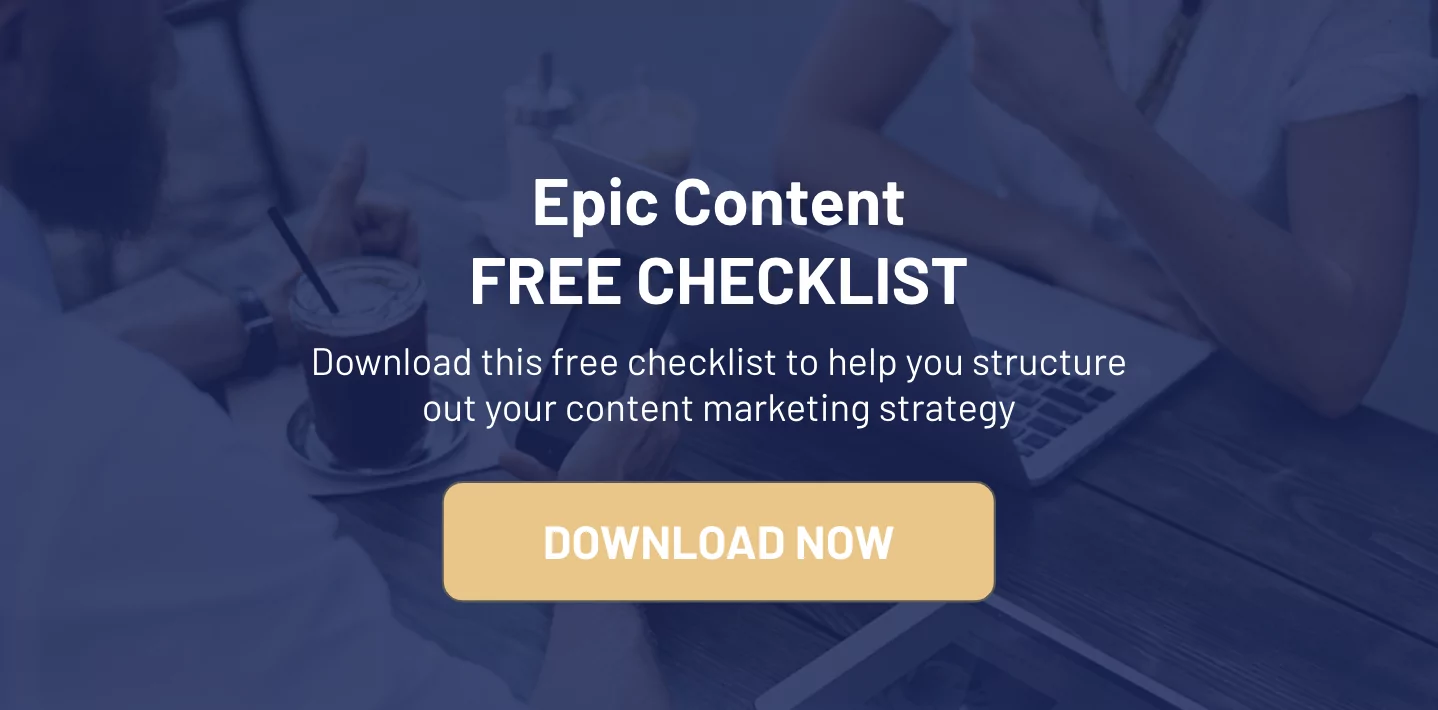Are you creating content to help build your brand and promote your business? In this guide, we reveal the key principles of epic content creation, featuring insights from successful content creators and entrepreneurs that use content marketing to attract and convert their ideal clients.
Over the past ten years, content marketing has picked up some major steam as a primary driver of brand awareness and customer acquisition for businesses. Today, almost every company creates and promotes free content to attract customers.
According to a 2017 report by Content Marketing Institute, 91% of organizations use content marketing to market their products, services, or to support prospects or existing customers.
This statistic shouldn’t surprise you. Billions of people around the globe now have access to the internet. And since consumers in every industry are turning to the internet to search for information, it makes sense to be the one providing your target audience with the information they’re searching for.
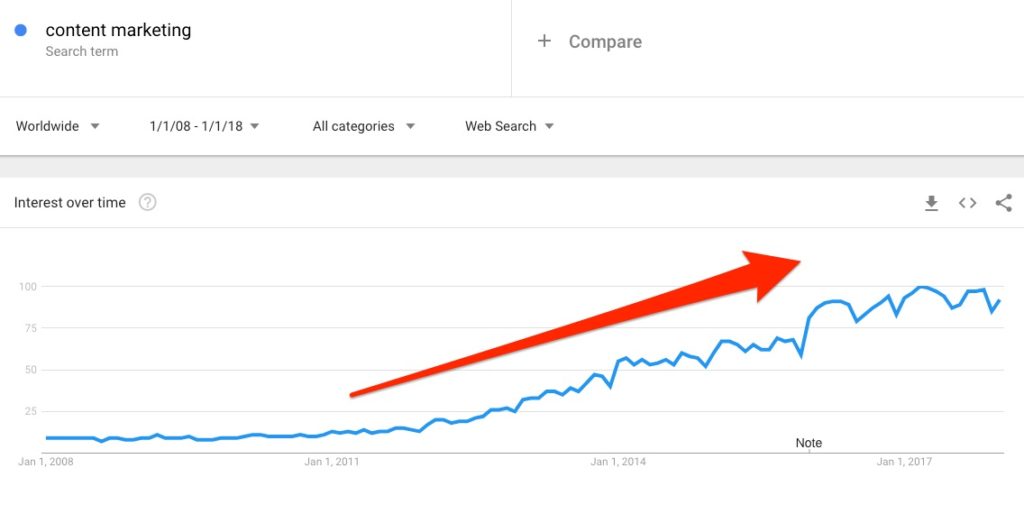
With so much content available (both online and offline), the competition for your target audience’s attention has never been fiercer. As best-selling author and internet personality Gary Vaynerchuk warned us in his presentation for Global Synergy Forum in 2017: attention is the new currency.
So how can you capture your target audience’s attention with your content, when they’re likely drowning in an abundance of content already?
By creating better content. By creating epic content.
Epic content is the only content that deserves attention
If you’ve only just recently realized that your content needs to be epic in order to stand out (or perhaps you’re learning this now!), welcome to the club.
A recent Google search for “how to create epic content” revealed over 10 million search results. So yes, a lot of people and companies know that creating mediocre content isn’t going to cut it, and they’re investing time and energy into learning how to create epic content for their audience and customers.

Interestingly enough, most of the content that appeared in these search results were blog posts about how to write epic blog posts.
Rather than tackling the same topic that has already been covered by so many incredible content creators, we decided not to approach this topic from a different angle. Instead, we decided to ask: what exactly makes content so epic, regardless of what type of content it is?
In other words, what are the underlying principles for creating epic content that apply not just to writing blog posts, but also to creating videos, podcasts, webinars, keynotes presentations, slideshows, books, online courses, or any other format that you choose to share your information in?
To that end, we reached out to dozens of successful entrepreneurs and content creators – from bloggers to published authors, video marketers, podcast hosts, online course creators, and professional speakers – to ask for their advice.
Based on their insights, we’ve identified the common thread of principles and tactics that they’re using to create epic content to attract and engage their respective audiences.
We’ve also included some examples of epic content throughout this guide so you can see these principles and tactics in action.
Why You Should Create Epic How-To Content
Before we dive into how to create epic content, let’s discuss why you should be creating epic content. And more specifically, why you should create epic “how-to” content for your audience and customers.
Your customers aren’t searching for information. They’re searching for a solution.
Every product or service is a solution to a problem. When your customer buys your product or service, what they are buying is the solution to a specific problem or the promise of a specific result – whether it’s saving time, better health, making more money, better relationships, a feeling of status, etc.
In their quest to find a solution to their problem, they’re searching for information that can help them. This is why, as a business, it makes sense to create content that educates your target audience, and that ties directly to the problem/result that your business helps your customers solve/achieve.
By helping your audience solve a specific problem or achieve a specific result, you are literally changing their life in some way (hopefully for the better!), while simultaneously increasing awareness for your business in the process.
But helping your target audience isn’t the only benefit to creating epic content. There are other benefits that extend beyond the impact you can make in someone else’s life.
Main benefits of creating epic content:
- Attention: Competition for your target audience’s attention has never been fiercer. By creating content that is better than your competitors’ helps you to stand out in a crowded marketplace.
- Loyalty: When your audience gets tangible value your content, they are more likely to keep coming back for more. Epic content helps to create brand loyalty and encourage repeat visitors to your website.
- Influence: If your content is compelling enough to persuade someone to implement your advice (more on that later!), you can literally change someone’s life.
- Traffic: Major search engines such as Google love epic content. In fact, their algorithm is designed to detect the most relevant and helpful content for specific search terms, and display that content in their search results. Content that ranks high in search engines can become a continued source of free traffic to your website.
- Authority: Creating in-depth content for your audience helps to position you as an expert and an authority in your industry. This builds trust, and once someone trusts you, they are more likely to buy from you.
- Virality: No amount of promotion will help mediocre content go viral. For something to go viral, people need to share is organically. Content that is truly epic has built-in virality and is more likely to be shared by those who consume it.
“When you create outstanding content, you won’t have to struggle to promote it. Creating viral content is about hiding your digital marketing within great content, and organically reaping the promotional rewards for those efforts.”
– Neil Patel, neilpatel.com
Epic content defined:
Before you try to create epic content, you should probably be able to define it first.
Having a clear definition of epic content is will enable you to accurately gauge whether or not your content is truly epic, and to recognize it in the content of other companies, including your competitors.
The first question we asked the successful content creators we reached out to was how they define epic content. Although the specific language they used to define epic content varied, every one of their definitions alluded to at least one of 3 specific principles.
Here are a few of the definitions that were shared with us. See if you can guess what those 3 principles are:
- “Epic content is when someone views it, it evokes the immediate reaction of someone wanting to share, subscribe, follow, or link to the piece of content. That’s often the result of the piece of content being so valuable to the viewer, that they become a raving fan.” (Stefan James, projectlifemastery.com)
- “Content that after consuming it, and if you put into action could dramatically impact your life or business.” (Nathan Chan, foundr.com)
- “Content that speaks to something inside people – that makes them say “yes!” They want to share it – it made them smile, think, laugh, change something for the better. When you leave people better off in some way – even if it’s just making them feel good and make them feel that they can do something great – that’s epic to me. Lift people up and they remember you.” (Kathy Klotz-Guest, keepingithuman.com)
- “Something that makes an impression, sticks in people’s’ minds, informs their thinking, and changes their actions.” (Danny Iny, mirasee.com)
- “Content that provides a new perspective, that gives the reader an “aha” moment. No ideas are new, but when presented in a new “epic” way they can create a new thought in the reader’s mind. That’s what I’m always striving for.” (Pia Silva, worstofalldesign.com)
- “Epic content to me is shareable, relevant and entertaining.” (Katya Varbanova, livestreamincome.com)
- “Content that gets real results in someone’s life.” (Grant Cardone, grantcardone.com)
As you might have noticed, every one of these definitions of epic content alludes to at least one of the following principles:
- Highly useful
- Entertaining
- Inspires action
In fact, one of the entrepreneurs we reached out to managed to include all 3 principles in his definition. Well done, Chris Ducker!
“Epic content is any type of content that’ll ultimately change the game for those consuming it. It should always be at least educational, inspiring or entertaining – and if possible, all three rolled into one. Epic content should also be highly shareable (as well as consumable!).”
– Chris Ducker, chrisducker.com
There’s actually a 4th principle as well (which Chris Ducker included in his definition), but since the 4th principle is a byproduct of the other 3, we’ve listed it separately. That 4th principle is shareable.
Content that is highly useful, entertaining, and inspires action is more likely to be shared by your audience than content that lacks any of these 3 core principles. We call this the Epic Content Equation:
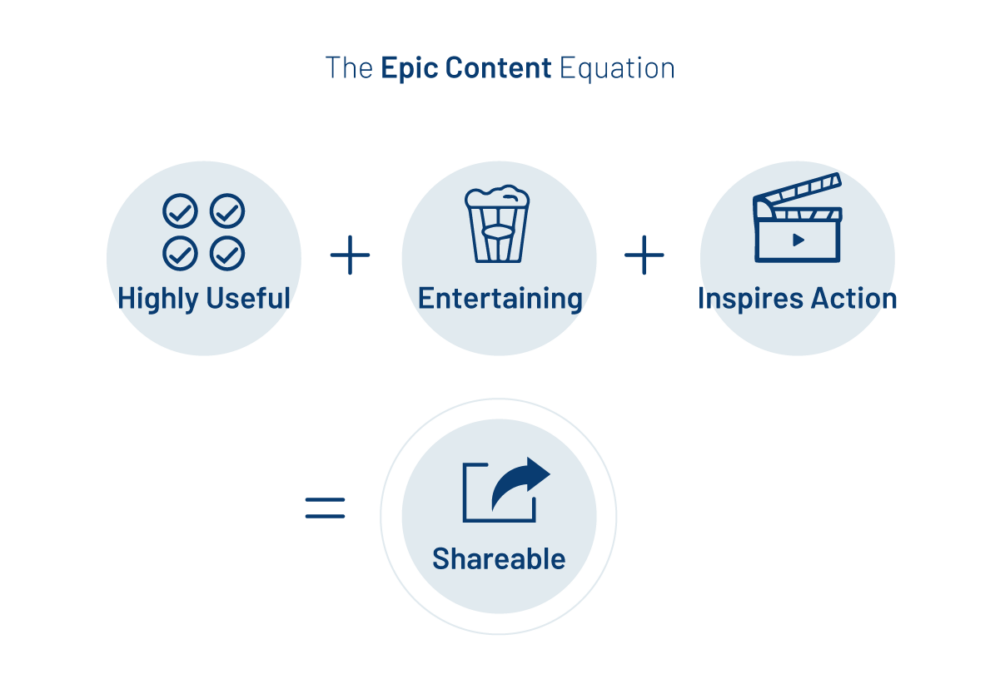
3 Keys to Creating Epic Content Your Audience Will Love
Now that you understand the underlying principles of epic content, let’s dive into each principle individually, including specific tactics you can implement for each one.
1. Create Content That Is Highly Useful
The goal: to create content about a specific topic for a specific target audience
The metric: usefulness to your target audience. How relevant and valuable is the topic to them?
Tips for creating content that is highly useful:
Choose a relevant topic (to your target audience)
When choosing a topic to create content on, we recommend identifying one specific aspect of a larger problem that your business helps your customers solve. Focus on one specific topic, scenario, or outcome for the piece of content that you create.
If you’re a financial planner, for example, you might choose “how to create a household budget” as one of several topics that relate to financial planning. Leave other topics (such as investing, negotiating a higher salary, saving for a child’s education, estate planning, etc.) for other pieces of content.
Next, use a keyword research tool such as Google’s Keyword Planner or Moz Keyword Explorer to validate the demand for your topic. The goal here is to gauge how many people are actually searching for this topic online and to identify precisely which search terms/keywords they are using to search for that topic.
“The first step to creating impactful content is super simple: know who you’re creating the content for and genuinely care about them. The second step that I would highly recommend before creating content is to do some really solid market research on your topic and how it will serve your audience. The last thing you want to do is to create content based on what you think they want just to find out that they don’t want it at all.”
– Dr. Carrie Rose, of-course.us
Choose a content type
Once you’ve validated the demand for a specific topic, the next step is to choose which type of content to create. Although you can certainly repurpose your content into other formats (this helps accommodate different learning styles), we recommend starting with a primary content type that makes the most sense for your topic, target audience, and goals for your content.
If you need to visually demonstrate how to do something, creating a video makes sense. If you’re interviewing an expert, a podcast interview in audio format might be more suitable.
Rand Fishkin, Founder of Moz, for example, does an excellent job of repurposing the videos from his popular Whiteboard Friday series into multiple forms of content including graphics, audio podcasts, and text transcriptions on Moz’s blog (see example here):
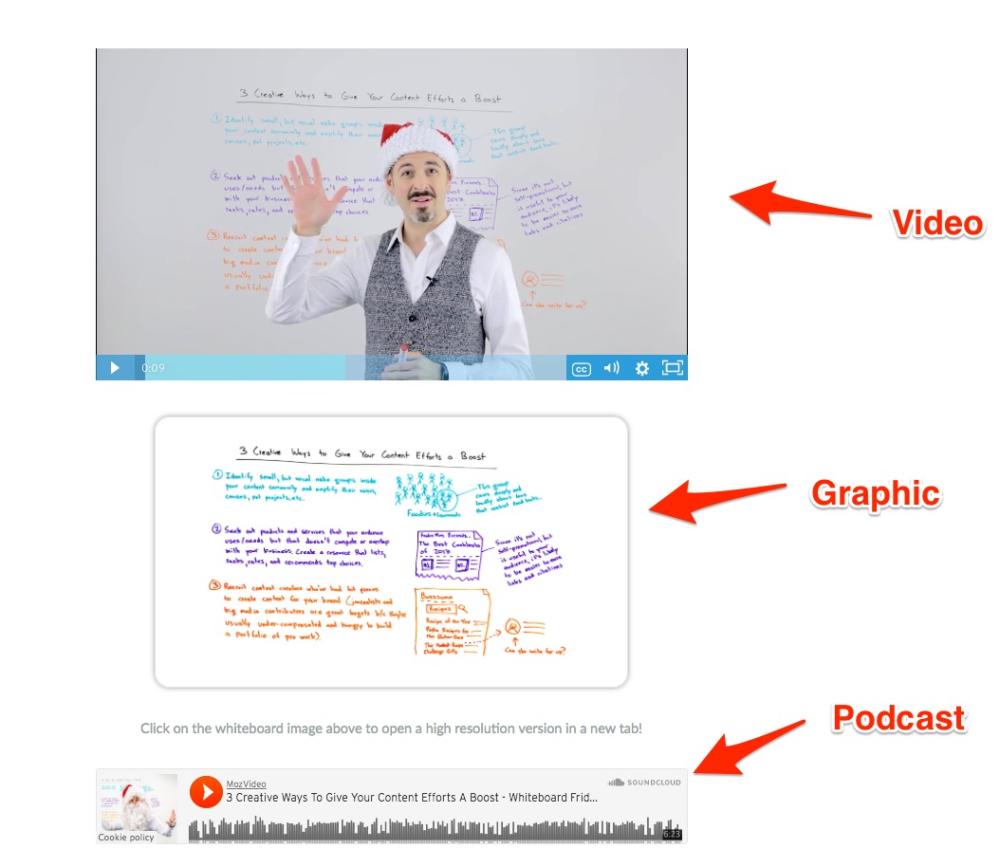
“Epic content is timeless, validated, and highly engaging. It’s content that doesn’t just scratch the surface on a matter—it presents well thought out information and puts the user’s experience first. The delivery modality can differ from creator to creator as long as overall quality—quality of information, quality of craftsmanship, quality of production—is a priority.”
– Amanda Bond, theadstrategist.com
Craft a compelling title/headline
The title/headline you give to your content will likely be the first thing someone looks at to evaluate whether or not it deserves more of their attention. Make a specific promise without giving away the solution entirely or deceiving your audience. If your headline doesn’t lure your audience by arousing their curiosity, it isn’t compelling enough.
Try to come up with at least 5-10 different titles/headlines for your content, and then choose the one that is the most compelling. CoSchedule has a free Headline Analyzer Tool that you can use to help you come up with a compelling headline for your content.

“Your headline should not promise them a trip to the moon and back — readers are way too swift for such shenanigans. Keep the benefit specific and narrow, and readers will feel compelled to click and get the solution to what’s bugging them.”
– Liz Longacre, smartblogger.com
Conduct extensive research on your topic
Your goal when creating content should be to create the best piece of content about your specific topic. In order to accomplish this, you’ll need to do some research to find out what you’re competing against.
As you research competing pieces of content, look for gaps to fill or an opportunity to cover the same topic but from a difficult angle. Your content needs to be better, more detailed, or different in some way in order to stand out.
We recommend using BuzzSumo to identify top performing content (measured by total shares on social media) for your chosen topic and to identify top performing content on specific websites, including the websites of your competitors.
Make note of any data, statistics, examples or important concepts from credible sources, so that you can reference them in your content. Whenever possible, include your own data or unique insights in your content.
One of our favorite research methods is to reach out to other experts and ask them to contribute their insights. We typically do this by sending them a link to a short survey, and in some cases, by interviewing them as a guest expert on our YouTube channel.

Gather as many insights and ideas as possible for your topic (but try to resist the temptation to over-do it!). The next step will be to organize those insights, which brings us to our next point:
Present your ideas methodically (step-by-step)
Clarify the big idea for your content, and then organize all of your supporting insights and ideas (your “raw material”) into themes and/or steps that support your big idea. Your goal is to present your ideas in a methodical and logical sequence that guides your audience from Point A (their current reality) to Point B (their desired reality).
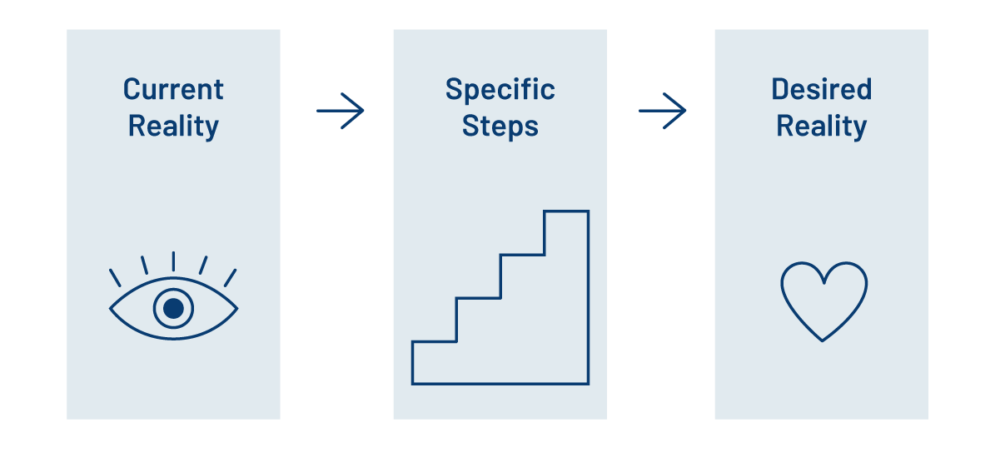
To help illustrate how this process works, I’ve included a behind-the-scenes snapshot of my research and organization process for this guide (see screenshot below).
Once I clarified my big idea (“how to create epic content”), I started doing research to gather as many ideas and concepts that relate to my big idea as possible. These ideas and concepts became my raw materials. From there, I started grouping those ideas into specific themes/categories that support my big idea – which in this case, resulted in the 3 principles of creating epic content. I did all of this using a simple Google Doc:
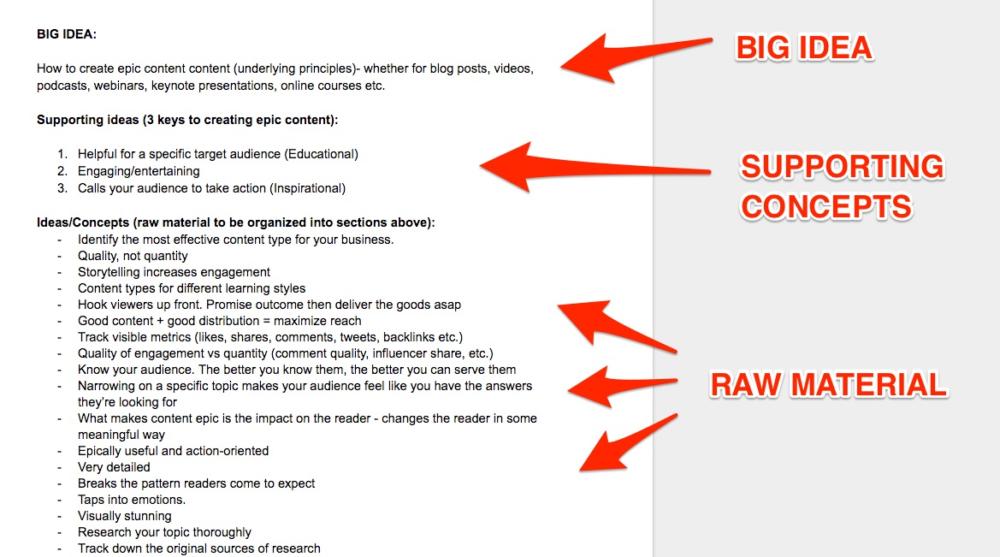
“Start with the key insight that, if internalized, will change everything for the reader. Then build on that until everything that needs to go with it for coherence and clarity are included.”
– Danny Iny, mirasee.com
Cover your topic in detail
Once you’ve organized all of the supporting ideas/concepts for your big idea into specific themes or categories, it’s time to start creating your masterpiece.
Depending on the type of content you’re creating (blog post, podcast episode, video, slideshow, etc.), your content creation process may vary, but our advice remains the same: cover your topic in detail.
Share as much information about your topic as you can, to the extent that it is still useful and relevant to your topic. Deliver on the promise of your content’s topic/headline, but don’t overwhelm your audience with too much information. Break up your main ideas/concepts using subheadings or bullet points to help your audience process your information effectively.
Here are some questions to ask yourself before you publish your content:
- Is my information complete? Did I miss any critical steps or concepts?
- Is there any fluff/filler content (content that does not add value to the topic) that can be removed?
- Did I answer questions/handle objections my target audience might have?
“Always ask yourself and constantly push yourself on how you can do more with that piece, and when I say more I don’t mean more as in increased volume, I mean more as in the value that the piece provides. Compare yourself to what is currently in the marketplace, and ask yourself: is yours the best? If it isn’t, keep working on it.”
– Nathan Chan, foundr.com
Showcase Your Credibility
Whenever you how-to create content, make sure your insights come from credible sources and/or your own experience, ideally both. Don’t create content on topics for which you have little or no experience. There are plenty of people in the world sharing questionable and unverified advice already. Don’t be one of them!
Give credit where credit is due, and always check your sources to make sure they are reliable. For better or worse, every piece of content that you produce is a reflection of your brand. Always do your best to ensure your content is reliable and credible, and don’t hesitate to update older content as you discover new insights and data.
As billionaire investor Warren Buffett once said: “It takes 20 years to build a reputation and five minutes to ruin it. If you think about that, you’ll do things differently.”
How to Create Epic Content Your Customers Will Love (Complete Guide) Click To Tweet“Create content about something that you truly know and understand. When you understand everything about the subject, from all angles, you’ll be able to provide your audience with a perspective that is truly valuable.”
– Taylor Loren, later.com
2. Create Content That Is Entertaining
The goal: to create content that captures and holds the attention of your target audience
The metric: engagement (consumption time, likes, shares, comments)
Tips for creating content that is entertaining:
Hook your audience early on
Make a bold promise to your audience early in your content. This helps “hook” your audience early on and gives them a reason to continue paying attention. Tell your audience what you are going to teach them, and then transition quickly into actually teaching them. If your content doesn’t start helping your audience quickly, they will drop off and look for another piece of content that does.
Ramit Sethi’s Ultimate Guide to Making Money (one of the most shared free guides about making money on the internet), for example, begins with a clear headline, a compelling question, and a few short paragraphs to immediately hook readers:
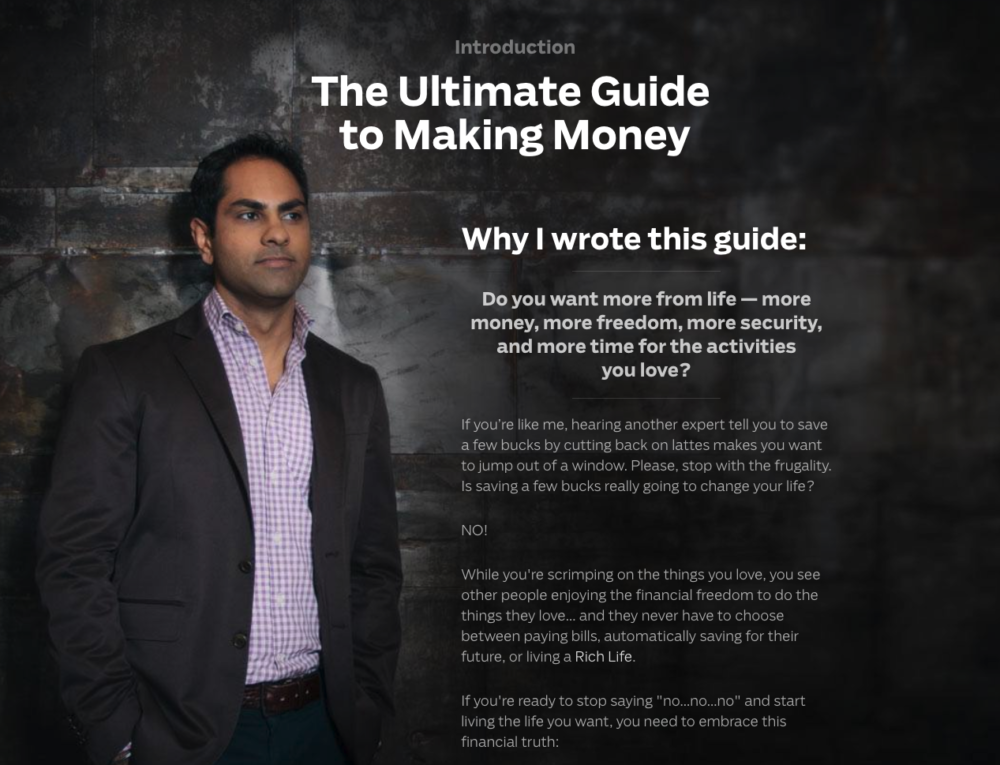
“To create epic content, you have to be educational but also entertaining. I call it edutainment.”
– Grant Cardone, grantcardone.com
Evoke an emotional response
Most people won’t remember what you say, but they will always remember how you made them feel. For your content to be memorable, it must evoke an emotional response. If your content doesn’t make your audience feel something, they will soon forget it.
Creating content that evokes an emotional response begins with understanding your target audience. You should know their pain points, fears, frustrations, desires, motivations and aspirations, and tap into them in your content. Articulate the problem that your audience is itching to solve, show them that you understand how they feel and that you can relate to them.
A great example of a piece of content that evokes an emotional response is a video titled “The Life of an Entrepreneur in 90 Seconds” by Patrick Bet-David. With over 2 million views on YouTube, we can safely assume that any entrepreneur that watches this video can immediately relate to it and is likely to share it with others.
“Epic content is an opinion based on the perception of the consumer. Therefore, to create epic content, you must KNOW your audience extremely well so you can hit their emotional hot buttons to trigger an “epic” response.”
– Mark Lack, shortenthegap.com
Challenge your audience’s assumptions
Don’t be afraid to challenge your audience’s assumptions about your topic. If the current trend in your industry is to do things a certain way, don’t hesitate to go against the trend and recommend a different solution. Telling people what not to do is often just as valuable as telling them what to do.
Show your audience that you understand what they’re going through and that you’re well aware of the advice that they’ve probably been given about your topic. If you disagree with that advice, tell them why and recommend an alternative solution. Whether your audience adopts your recommendations or not, when you challenge their assumptions, they pay attention.
Tell a story your audience can relate to
In the book Building a StoryBrand, author Donald Miller emphasizes the importance (and effectiveness!) of using storytelling in your company’s marketing and communication with your customers.
According to Donald Miller, every story is about someone who is trying to solve a problem. So when you identify your customers’ problems and tell stories that articulate those problems and present solutions, your customers will recognize you as a brand that understands them.
The more you tell stories that your customers can relate to, the more likely they are to engage with your content and perceive your business as a trusted resource whose products and services can help them solve their problems or achieve their desired results.
“The customer is the hero of the story, not your brand. When we position our customer as the hero and ourselves as the guide, we will be recognized as a trusted resource to help them overcome their challenges.”
– Donald Miller, buildingastorybrand.com
Use relevant language
Be mindful of the language you use in your content because the language you use can either attract or repel your target audience.
To attract your target audience, you must use the same language in your content that they would use. Use terminology that they use regularly. Describe a problem the way that they would describe it. Present your solutions in a way that makes sense to them.
If your target audience is just getting started with learning about your topic, avoid using industry lingo that only an experienced professional would understand. Similarly, if you do use advanced terminology and industry lingo in your content, know that you will likely exclude those who cannot understand or relate to your language.
Gary Vaynerchuk, for example, often curses in his videos, interviews, and keynote presentations. Does this offend some audiences? Absolutely. There are plenty of people out there who say they don’t like Gary Vaynerchuk for this exact reason.
But Gary Vaynerchuk, like most successful content creators, understands that in order to attract people who resonate with his message and delivery style, he must be willing to repel those who do not. He made a conscious decision to be polarizing with his language, and he has a massive following of loyal fans who appreciate his authenticity and lack of a filter as a result.
“Put yourself in your target audience’s shoes. Be 100% transparent and share your most true experiences. Do not hold back. Do not put any filters on anything. People want to see the losses just as much as they see the wins. With the internet, it’s easy for content creators to only paint the picture of the dream… but I’m finding more that people like to see the pain, struggle, frustration as well because they can relate to that.”
– Kevin Stimpson, strivengrind.com
3. Create Content That Inspires Action
The goal: to inspire your audience to take a specific action (implementation)
The metric: conversion rate from passive consumption to execution of the desired action
Tips for inspiring your audience to take action:
Tap into your audience’s motivation
According to psychologists, there are two primary forces that drive human behavior: the desire to avoid pain and the desire to gain pleasure.
In a guide by Robbins Research International, life and business strategist Tony Robbins offers the following advice:
To access leverage, you must help someone associate massive PAIN to not changing NOW, and massive PLEASURE to changing immediately. The motivation is based on both pain AND pleasure. Pain is short-term motivation, but you need the pleasure side for long-term motivation.
To inspire your audience to change and/or take action, your content should address the problem they want to solve (their pain/current reality) as well as the benefits of your proposed solution (their pleasure/desired reality).
“The real value of any educational content is when it’s applied. You need to get the viewer to actually apply what they’ve learned, and to do that, you must make it a must for them. Make whatever it is you want them to do be irresistible. That often is done by explaining the benefits (the pleasure), as well as the consequences (the pain) of not taking action.”
– Stefan James, projectlifemastery.com
Include social proof
When you’re trying to teach someone how to solve a specific problem or achieve a specific result, the most important thing you can do for them is to help them believe in their ability to do it. This concept is known as self-efficacy, which is defined as a person’s belief in their ability to succeed.
If your audience doesn’t believe they can do something, it doesn’t matter how clearly you articulate the required steps to them, they won’t take action. They need to believe that the new reality you’re promising them is possible for them.
The way you do this is through social proof. Show your audience examples of other people just like them that have followed the steps you are teaching and achieved the result you are promising. The vast majority of your audience needs to see social proof before they will take any action.
“Everything I do is around action. If they read/watch and do not implement then they wasted their time. Telling them what to do in small bite-sized chunks that don’t seem overwhelming, plus showing them the results they can expect or reasons this WILL work for them is important.”
– Jaime Masters, eventualmillionaire.com
Provide a clear next step
Every piece of content you produce should always contain a clear next step (a call to action) for your audience to take. Whether it’s to subscribe to your email newsletter, download a supplementary resource, register for a webinar, sign up for a free trial, or schedule a phone call, etc. – always give your audience a next step to take.
Never leave your audience wondering what they should do next, and never assume that they will know what you want them to do. Always provide them with a clear next step to help them implement what they’ve learned, engage with your brand, or consume additional content.
How to Create Epic Content Your Customers Will Love (Complete Guide) Click To Tweet“Don’t oversell – providing value and education that connects the right problem with the right customer at the right time is more than enough to convert them.”
– Taylor Loren, later.com
Polish Your Content Before You Publish It
Once you’ve incorporated all 3 principles (useful, entertaining, inspiring) into your content, here are some things you can do to polish it before you publish it and promote it to your audience:
Review and edit
As a general rule, you should avoid trying to edit your content while you’re creating it. Creation and editing are separate stages of the content creation process and should be treated as such.
Implement a formal review and approval process for all content before it gets published. A second set of eyes will often detect mistakes or inconsistencies in your content that you missed.
When editing your content, look for spelling/grammatical errors, formatting consistency, and proper credit/links for research sources. Grammarly is a great tool for detecting grammatical errors in written content.
Using a project management tool such as Trello or Asana, I recommend creating a content calendar. This makes it easy to track each piece of content through the various stages of content creation (research, editing, scheduled, promotion, etc.), and to assign specific tasks and deadlines to various team members throughout the process.

“Don’t try to cram too much into one presentation. Focus on one main idea and build support for that idea with your teaching points.”
– Jon Schumacher, jonschumacher.com
Keep only what is essential
Do one final check to make sure that only what is essential is included. Get rid of any fluff, filler, or irrelevant content that does not add value to your audience and support your main topic.
This is easier said than done. If your content contains an idea/concept that is valuable but not necessarily relevant to your topic, remove it and save it for a future piece of content that it would be more suitable for.
“Know your audience and stay on topic. Get rid of the fluff. Once you know your purpose with your content (which should be to generate a specific result for those consuming it), stick to teaching how they can achieve that result.”
– John Lee Dumas, eofire.com
Add visuals
Approximately 65% of the population are visual learners (Social Science Research Network). This means that most people need to see what you are teaching them in order to grasp it effectively. Even if your content is primarily text-based (an article or blog post, for example), adding visuals such as images, diagrams, and charts will help to make your content more engaging and memorable for your audience.
Several years ago, I watched a keynote presentation by Seth Godin, a highly respected and prolific writer and marketer. I don’t even remember seeing any bullet points in his presentation slides. There may have been a statistic or two in there somewhere (to show research/credibility), but for the most part, his entire presentation consisted of visuals and telling stories. It was one of the most captivating keynote presentations I’ve ever seen.
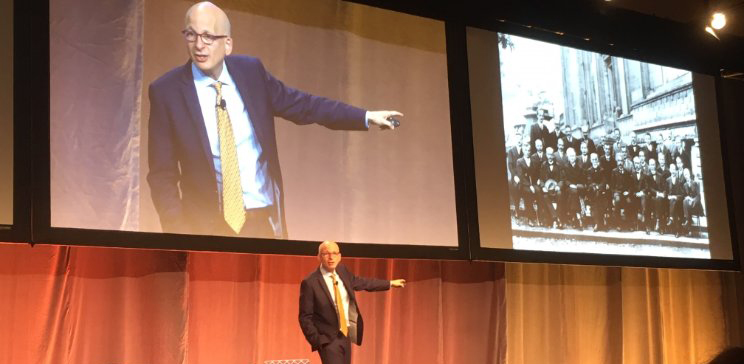
“Invest in visuals. Find good images across the web that enhance the points you make. Animated Gif images can also add a lot of value when explaining ideas. Or invest in a designer to create some custom graphics. Make sure the quality of your visuals is very high, don’t use blurry, distorted or images with the “stock photo” watermark splattered on them.”
– Kyle Gray, thestoryengine.co
Optimize for search engines
An essential quality of epic content is discoverability. If your target audience is searching for information about your topic and they can’t find your content, you are doing them a disservice.
Whether you publish your content on your own website or some other platform, make sure that you spend time understanding how your audience searches for your topic and optimizing your content to appear in their search results.
At a minimum, your content and/or the webpage that it’s published on should include a title, description, and relevant keywords/tags to help search engines discover and rank your content in search results. We use Yoast SEO (a WordPress plugin) to optimize our blog posts for search engine optimization, but this same principle applies to all types of content that are published online, including podcast episodes, YouTube videos, webinars, books and online courses.
To learn more about search engine optimization, we recommend reading The Beginner’s Guide to SEO by Moz.
Optimize for sharing
If your content is highly useful, educational, and inspiring, then it is already more likely to be shared by others than content that is not. But that doesn’t mean that you shouldn’t encourage your audience to share your content and make it easy for them to do so.
Add social sharing buttons to your content (if it’s published on your website) to make it easier for your audience to share your content. Conclude your content by asking your audience to share it with others if they enjoyed it and found it to be helpful for them.
YouTube marketing expert Sunny Lenarduzzi, for example, often concludes her videos by encouraging her viewers to like and share her videos, and to subscribe to her YouTube channel:
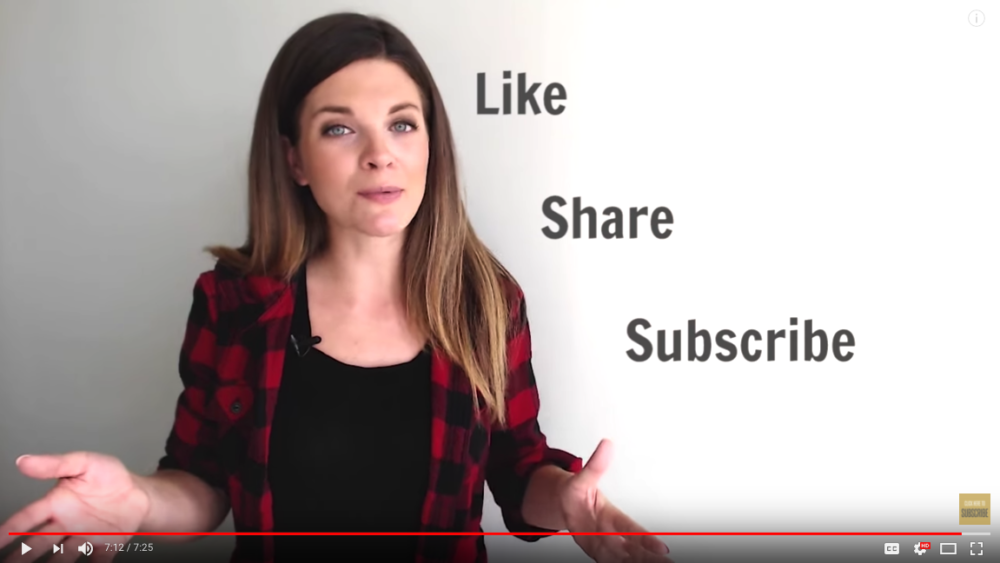
Download our Epic Content Checklist
Congratulations for making it to the end of this guide! I hope that it was helpful for you, and I commend you for your commitment to learning how to create epic content for your audience and customers.
Remember, 91% of organizations regularly create content to market their products, services, or to support prospects or existing customers. I suspect it won’t be long before the other 9% start catching up. So yes, if you’re creating content to attract customers, you have some competition.
By adhering to the key principles outlined in this guide, and by following the example of other companies that are creating content successfully, you will be well equipped to create epic content that attracts your ideal customers, establishes trust and authority in your industry, and most importantly, helps to change lives.
If you enjoyed this guide, feel free to bookmark it for future reference, leave a comment below, or share it with your network.
For your convenience, we also created an Epic Content Creation Checklist, which you can download below:
How to Create Epic Content Your Customers Will Love (Complete Guide) Click To Tweet

